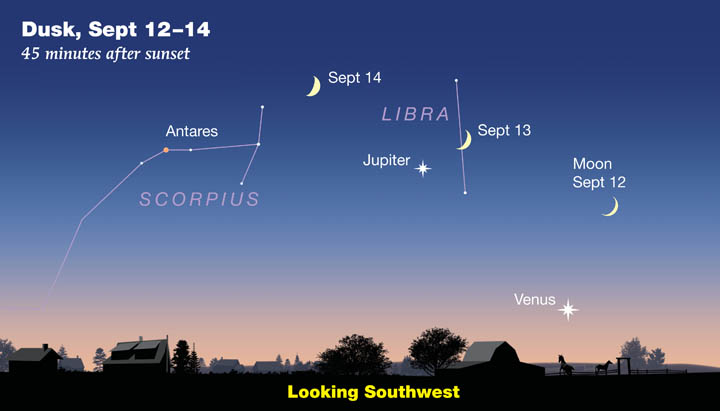As told in this month's astronomy podcast, Venus is disappearing in the west after sunset. So September offers you a final chance to see four bright planets at once.
Ask an astronomer about September’s astronomical significance, and the answer you’ll most likely get is: “the autumnal equinox.” It marks the celestial end of summer and the beginning of autumn in the Northern Hemisphere.
This year, September’s equinox takes place on the 22nd at 9:54 p.m. Eastern Daylight Time. At that moment the Sun shines directly overhead as seen from the equator. Days and nights are both 12 hours long — that’s where the word equinox comes from — and no matter where you live the Sun rises due east and sets due west.

Sky & Telescope
Of course, there's more going on this month than a celestial change of seasons. If you've got a clear view toward the west, you can still spot four bright planets in one wide sweep soon after sunset. Venus starts the parade low in the west. Then shift your gaze to the left to sweep up Jupiter, Saturn, and Mars.
This month's astronomy podcast leads you on a guided your of the evening sky that includes stops at some of the lesser-known constellations in view right now: Capricornus, which hugs the southern horizon, and Draco, Hercules, and Corona Borealis, all found in the northern half of the evening sky.
And of course you almost can't miss the Summer Triangle — the stellar trio of Vega, Deneb, and Altair — that are cruising nearly overhead as evening twilight ends. If you have to fight light pollution to see the stars, you'll have your best chance to see the Milky Way if you look overhead near Deneb. As it turns out, some of the Milky Way's richest concentrations of stars are in the its vicinity.
There more to see in the nighttime sky. So to get all the celestial highlights in the weeks ahead — and that all-important Perseid meteor forecast — play or download this month's 7-minute-long astronomy podcast (linked below).
Podcast: Play in new window | Download
Subscribe: Apple Podcasts | Google Podcasts | Spotify | Email | RSS | More
 0
0
Comments
You must be logged in to post a comment.